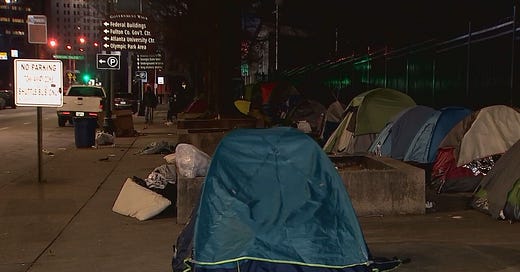On Thursday, January 16th, a man was crushed to death in his sleep by either a bulldozer or a garbage truck as part of Atlanta’s targeted destruction of homeless encampments. He was personable, had a family, and liked to draw. The tent neighborhood in which this man lived is one of many clusters which have sprung up near highway on-ramps, public parks, church parking lots, and numerous other gaps between the lifeless high-rise condos and vacant commercial office towers the city attempts to stage into a convincingly inhabited backdrop for visitors during major tourist events.
On Saturday, January 18th, two years had passed since the first public execution of a climate activist by representatives of the U.S. state - two years since a mother’s loss of her child to nearly a dozen police bullets. The same child that once spent Christmas handing out their own gifts to neighborhood kids left the world as an adult bleeding out in a tent in a public park in South Atlanta for the sake of construction contract fulfillment a mile away. The encampment in which this happened was established to protest and delay completion of a $100 million police training facility. It’s 1 among a constellation of 80 such projects throughout the United States, each of which is extremely obviously intended by authorities to function as a forward operating base for crisis management in the face of projected future social unrest, with the added benefit of enriching localized players in the construction and security sectors.
On Monday, January 20th, tourists from across the country will be circulating around downtown Atlanta in observance of Martin Luther King Jr. Day, exploring the man’s reliquaries and infusing local 5-over-1 gentrification stations with liquidity during the post-holiday slump. Monday also holds the 2025 College Football Playoffs at Mercedes-Benz stadium - likely a much more important priority for city leadership. Certainly worth a life.
It’s difficult to imagine a better illustration of the deep ugliness that characterizes this city and this country. A man’s life taken and his body destroyed like garbage, across the street from MLK’s Ebenezer Baptist Church. A church whose most recent well-known pastor has used his position steering the ship of state to assist in laying the legal groundwork for ethnic cleansing at home and routinely rubber-stamping material provision for the same in Palestine. All in advance of a holiday dedicated to the city’s hero, established by the very entity responsible for his death.
The murders of Manuel ‘Tortuguita’ Terán and Cornelius Taylor are also illustrative of something else. Each was a consequence of a ‘Clearing Operation’, contextually different but actualized through human hands guided by the same deeply anti-human logic. Consider that civil authorities are comfortable adopting the terminology of something like a forest logging operation (or an act of war) to frame the removal of inconvenient lives. This is intrinsically tied to the blank cruelty with which killings like these are perpetrated.
The public-private partnership which governs our lives continues only through the daily administration of direct and indirect violence. The omnipresence of this violence makes it a hypnotic undercurrent, often difficult to notice. It is usually easier to discern the face of this thing through it’s banal components. But it reserves a specific category of efficient, cauterizing destruction for those that intentionally or otherwise lie outside the contours of it’s shadow. And when these things happen it becomes visible in full. And it shows us, loudly, it’s criteria for determining the value of a human life.




